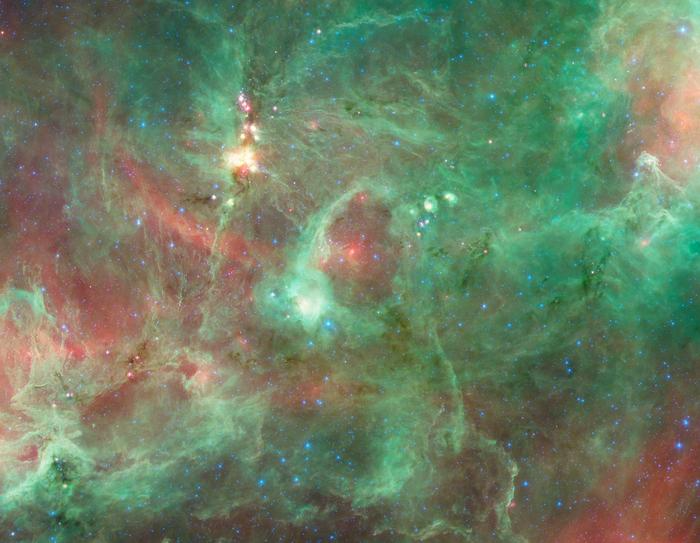A global team spearheaded by researchers from the University of Cologne has unraveled the enigma of a remarkable phenomenon referred to as the ‘Diamond Ring’ within the star-forming region of Cygnus X. This vast, ring-like formation composed of gas and dust bears a striking resemblance to a luminous diamond ring. In comparable structures, the formations typically exhibit a spherical rather than flat configuration. The origin of this unique shape had remained a mystery until now. The study was published in the journal Astronomy & Astrophysics.
 Image Credit: NASA/JPL-Caltech/Harvard-Smithsonian CfA
Image Credit: NASA/JPL-Caltech/Harvard-Smithsonian CfA
The ring measures approximately 20 light-years in diameter and emits a strong glow in infrared light. It is a remnant of a previous cosmic bubble that was created by the radiation and winds from a massive star. Unlike other similar objects, the 'Diamond Ring' lacks a rapidly expanding spherical shell and instead features only a slowly expanding ring.
For the first time, we observed the final stage of such a gas bubble in a distinctly flat cloud structure. The bubble has ‘burst’, because gases were able to escape into the thinner areas around it. All that remained was the particular flat shape.
Simon Dannhauer, Study Lead, Institute for Astrophysics, University of Cologne
Computer simulations indicate that the bubble initially expanded in every direction before subsequently escaping perpendicular to the cloud. What was left behind is the structure of the 'Diamond Ring' that can be observed today. This cosmic formation is estimated to be approximately 400,000 years old, which is relatively young in comparison to the lifespan of massive stars. Sebastian Vider from the University of Cologne conducted these computer simulations using the new 'RAMSES' supercomputer.
The bubble made up of ionized carbon was previously expanded by a hot star with a mass roughly 16 times greater than that of the Sun. This star raises the temperature of the gas and dust until it emits light.
Such observations are technically challenging and were only achievable with the assistance of the airborne observatory SOFIA (Stratospheric Observatory for Infrared Astronomy). Utilizing SOFIA, a modified Boeing aircraft that operates at altitudes of 13 km or higher, researchers are able to observe a spectrum of light that cannot be detected from the surface of the Earth.
By undertaking this research, the scientists successfully measured the gas movement with precision: The ring expands at approximately 1.3 km/sec, equating to about 4,700 km/h, which is relatively slow in comparison to analogous bubbles.
The study offers significant insights into the manner in which the radiation and winds from young stars mold their surroundings, thereby affecting the process of new star formation.
The ‘Diamond Ring’ is a prime example of how enormous the influence of individual stars can be on entire cloud complexes.
Dr. Nicola Schneider, Study Co-Author, University of Cologne
“Such processes are crucial for understanding the formation of stars in our Milky Way,” continued Dr. Robert Simon.
However, there remains a minor disappointment for romantics. The research further indicates that what appears to be a 'Diamond Ring' from the planet is actually made up of two separate objects. It appears that the 'Diamond', which is a grouping of young stars, is simply a component of the ring. In reality, it is situated several hundred light years in front of it.
Journal Reference:
Dannhauer, S., M., et al. (2025) The Diamond Ring in Cygnus X: Advanced stage of an expanding bubble of ionized carbon. DOI: 10.1051/0004-6361/202556159. https://www.aanda.org/articles/aa/full_html/2025/11/aa56159-25/aa56159-25.html